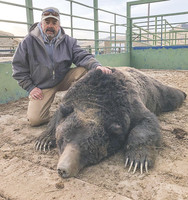Clear, 66° F
A giant grizzly that state wildlife managers euthanized in the Meeteetse area in early April is destined for a second life in education.
The boar was the biggest bear most experts had ever seen in …
This item is available in full to subscribers.
The Powell Tribune has expanded its online content. To continue reading, you will need to either log in to your subscriber account, or purchase a subscription.
If you are a current print subscriber, you can set up a free web account by clicking here.
If you already have a web account, but need to reset it, you can do so by clicking here.
If you would like to purchase a subscription click here.
Please log in to continue |
|


A giant grizzly that state wildlife managers euthanized in the Meeteetse area in early April is destined for a second life in education.
The boar was the biggest bear most experts had ever seen in the Yellowstone ecosystem, said Dusty Lasseter, large carnivore biologist for the Wyoming Game and Fish Department. Even after having just finished hibernating, the bear was well over 600 pounds. A grizzly will typically lose more than 25 percent of its weight during hibernation — meaning it would have gained at least another 150 pounds by fall.
“There are no records of [a grizzly] this big caught around here,” Lasseter said.
Had the bear lived through the summer, it likely would have been close to an 800-pound bear in the fall. Lasseter trapped the bear after repeated conflicts with livestock. It was a bad day at work, ending with the euthanization of a very special bear, he said.
“It’s one of the harder things we have to do. We always want to see these animals on the landscape. We all felt this was a very special bear,” he said.
The Game and Fish wanted to do something special to honor the giant and donated the bear to Meeteetse Museums. In 2000, a boar known as Little Wahb was donated to the Meeteetse Museum, part of a three-museum collaboration in the historic town. Little Wahb was big. Stories exaggerating its size grew even bigger. The Billings Gazette reported Little Wahb to be a 900-pounder that year. Despite its reputation, it’s no Big Joe, Lasseter said.
“Side by side, Big Joe will make Little Wahb look small,” Lasseter said.
Little Wahb, similarly euthanized for cattle depredation, is currently on display at the museum. Soon it will be easy to compare the size of the two bears; Big Joe is going to be stuffed as a full-body mount and used in a special educational display at the museum.
Big Joe, nicknamed for Meeteetse-area rancher Joe Thomas, had been relocated previously after conflicts.
Thomas has been seeing more bears on his property over the last decade, despite living just outside of Meeteetse.
“They move them, but they keep coming back,” Thomas said. “I always get a bear or two or three.”
Thomas has seen some depredation of his cattle but has mostly learned to live with the large carnivores. The last time a bear was trapped and removed from his property was about eight years ago, he said. The bear was about 25 years old and weighed over 500 pounds.
Thomas first saw Big Joe on April 4, just days after the bruin came out of hibernation. Thomas had also seen sows with their cubs on the expansive cattle ranch.
“More sows and cubs keep showing up here,” Thomas said.
After the boar was euthanized, Thomas photographed the bear, amazed by its size. He’s happy the bear will be used in an educational display, but he’s not so kicked up about the name chosen.
“That’s the name they picked. It’s no big deal to me,” Thomas said.
The display will feature modern technology to highlight drone footage taken by Thomas, DNA testing results, the history of the bear’s life and other aspects of grizzly education, said David Cunningham, director of the museums.
Meeteetse Museums are not alone in their attempt to create an interactive experience through technology. Museums, including the Draper Natural History Museum’s new golden eagle installation, are embracing tools from chatbots (computer programs which conduct a conversation via auditory or textual methods) to digital projections.
Some museums are even working to save you the trip. The Smithsonian American Art Museum, in Washington, D.C., is using virtual reality to bring its collections to patrons online.
Cunningham is more interested in getting visitors to come to Meeteetse. It’s hoped the new display will help drive traffic — especially during the offseason when Yellowstone National Park is closed, he said.
With some help, the museum will have a grand opening for the display within the next year. But first they need to find some donors.
“It will take a long time to raise the money to construct the educational display,” Cunningham said.
The price is still a mystery, but will run many thousands of dollars, depending on how much technology is used and the price of the full-body taxidermy by Nature’s Design, in Cody.
The museum is currently open five days a week (Tuesday through Saturday) due to a short staff, Cunningham said.
For more information or to donate, visit www.meeteetsemuseums.org.